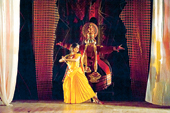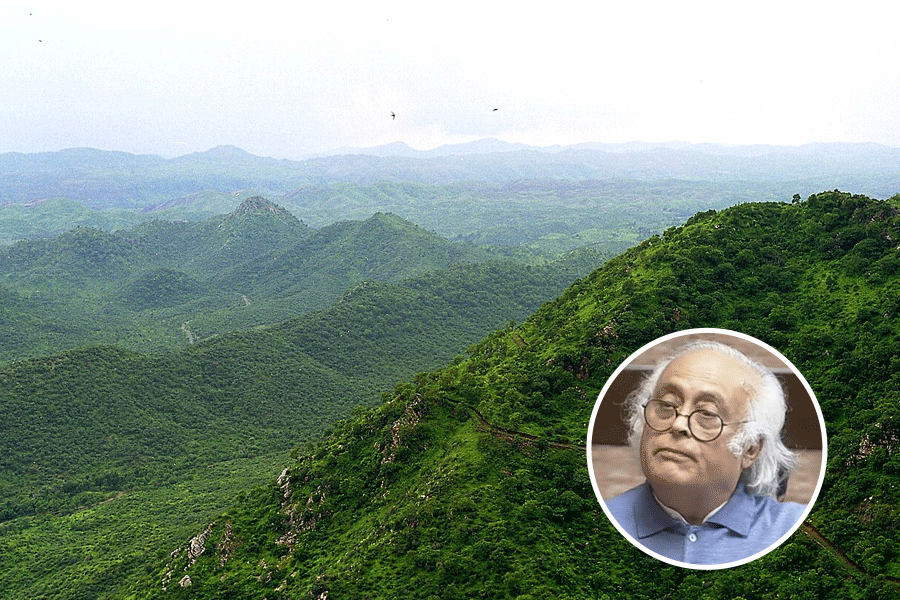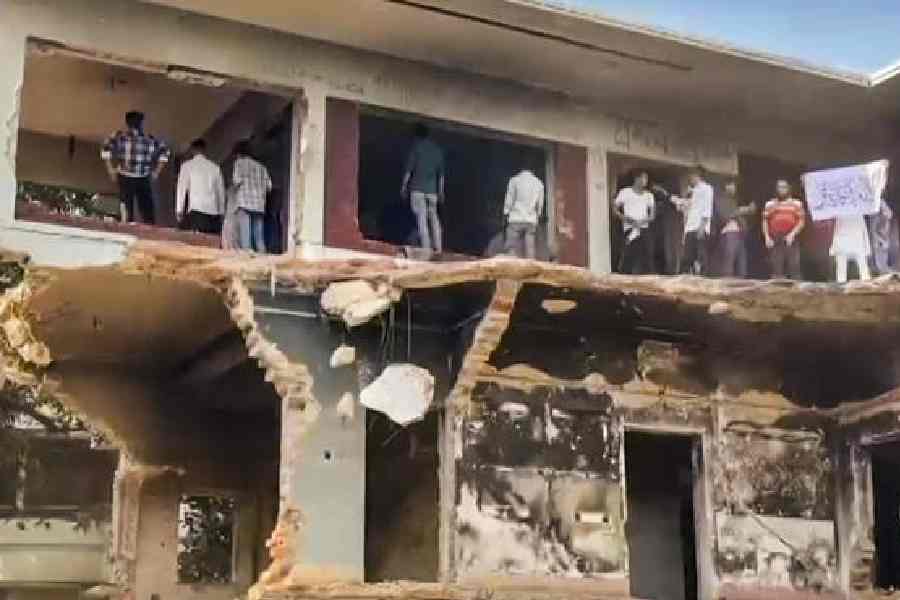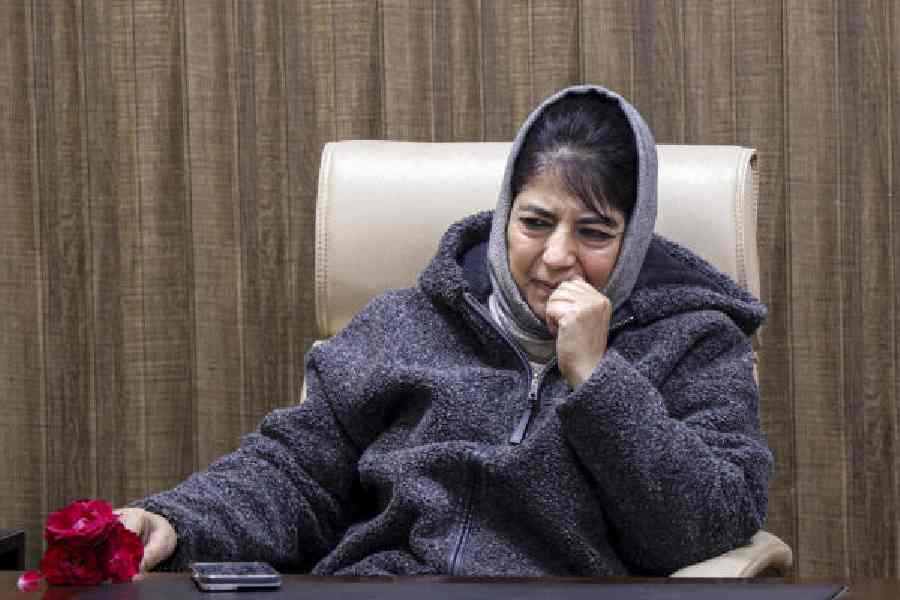 |
 |
| MIXED MEDIA: Raktakarabi staged as a dance drama by Jahnavi Centre for Performing Arts, Calcutta; (below) Bisarjan directed by Suman Mukhopadhyay |
All Rabindranath Tagore expected a hundred years on was that someone somewhere would be curious enough to pick up his poetry to read. What he’s getting 150 years after his birth is an avalanche of interest in his plays.
Bengal’s theatre crowd is busy like never before “trying to see contemporary political and social crises in the light of Tagore” or “trying to create new theatrical language such as Tagore would have wished”. According to Natya Akademi, there are over 1,000 theatre groups in Bengal. Many of them are already into action — at least 400 Tagore plays are on stage now. The other groups hope to launch Tagore productions during 2011-12, the anniversary year. A theatre worker, obviously intending to explain a “fad”, says: “All this is just phobia!”
Several “major” productions, Arun Mukhopadhyay’s Chirokumar Sabha, Kaushik Sen’s Birpurush, Suman Mukhopadhyay’s Bisarjan, Gautom Halder’s Raktakarabi, Arpita Ghosh’s Ghare Bairey, are daring to open a fresh dialogue with Tagore and trying to evaluate present conditions through interpretations of the texts.
An adaptation of a Tagore story, or even an episode from his life, is safe for many who feel overawed by Tagore’s plays. Sourav Banerjee of Kalabhrit, which sells theatre books, agrees that a collection of plays from Tagore’s stories Rabindra Galper Chhoto Natok is more popular than Tagore’s original works.
Soumitra Basu, who has dramatised Tagore’s works Tota Kahini (poem) and Sadharon Meye (poem), has just directed Jahara Tomar that links Ghora (poem) and Bidushak (story). Gobardanga Rupantar staged Dakghar last year treating it as an anti-war play. It is now launching Achalayatan that also draws on other works.
Kalindi Natya Srijan’s play on women’s emancipation is based on Tagore’s poem Nishkriti. In popular dramatist Chandan Sen’s version of the story Tyag, historic figures like Keshab Chandra Sen, Vidyasagar and Rammohun Roy are offenders of child marriage practices. Debashish Majumdar is busy with scripts for Tagore performances like Chandalika, a realistic Valmiki Pratibha and a play on the Jallianawala Bagh experience of Tagore. Jahnavi Centre for Performing Arts staged Raktakarabi (a play) as a dance drama that combines mime, Kathakali, Bharatnatyam, masks, installation and folk forms. Choreographer-dancer Madhuboni Chatterjee of the group is planning another dance-theatre project.
An average Bengali production usually costs Rs 2-3 lakh but Soumitra Mitra of Purba Paschim says that their Raktakarabi cost Rs 6 lakh, though Amaan and Ayaan Ali Khan took no money for the music.
Abhaas has hired stage stars such as Debshankar Haldar and Dulal Lahiri for its production of Gora, originally a novel, directed by Sekhar Sammadar because the text deals with “relevant” conflicts of caste, fanaticism, nationalism, urban and rural life. Production costs touched Rs 2.5 lakh.
Few takers in the past
Tagore was never so popular. Not even in his 100th year in 1961. In those days there were few theatre groups and fewer willing to try Tagore. Sombhu Mitra’s Bohurupee staged Bisarjan, but by then it had already done Char Adhyay (1951), Raktakarabi (1954), Dakghar (1957) and Muktadhara (1959), proving that Tagore could be staged.
Not all these productions were successful but they set a standard many felt was too high. “Doing Tagore posed two challenges: Tagore and Sombhu Mitra,” says Kaushik Sen.
The other groups were furtive dabblers — Theatron, Ritwik, Rupankar produced one or two plays. Pathasena took Tagore to the streets with Raktakarabi scripted by Badal Sircar. “I can hardly think of 20 productions worth mentioning in all these years,” says Ashok Mukhopadhyay of Theatre Workshop, who feels that the state needs a Rabindra Natya Charcha Kendra.
Performing Tagore in his homeland is not anything like performing Shakespeare in his, though Bengalis profess to being as enthusiastic about Tagore as the English-speaking are about Shakespeare. Of course, Shakespeare wrote only plays, barring the sonnets and the occasional poem. Even 300 years on, Shakespeare is alive and kicking as hard as ever on the English stage with his plays being interpreted and reinterpreted, successfully and unsuccessfully, and often controversially.
Evidence does not suggest a similar — and continuing — lively interest in Tagore on the Bengali stage. Original local plays being hard to come by, Bengal’s theatre groups have looked abroad rather than at Tagore. Does it then imply that they think Tagore’s works have lost relevance?
Kaushik Sen says after Nandigram, there was a spurt in Tagore productions. “People had been avoiding Tagore thinking his works could not be successful on stage, but somehow soon after the political crisis a lot of young people turned to Tagore. I did Dakghar and Bidushak in 2007.”
Even so there were not as many productions as are lining up today. Sen says he staged Birpurush with no grants and that he will not do a Tagore unless he has something to say, but “obviously people are eager to make the most of grants and other opportunities”.
Grants and opportunities. Of these now there are many, including the culture ministry project on Tagore, with a maximum award of Rs 5 lakh for a project (see box). Money is flowing in for Tagore this year, especially for works that reinterpret the originals.
Theatre groups, many of them facing a severe funds crunch, are eager to use every opportunity.
“There are three kinds of people involved (in the Tagore performances),” says director Bibhas Chakraborty. “One kind is going with the hujug (trend) and feels compelled to do something for the 150th year, thinking that doing Tagore would mean more “call shows” and mileage. Or maybe they feel doing Tagore now would exonerate them for ignoring the bard for so long. Why else would people who have never touched Tagore suddenly claim to be experts?” he asks.
“Then there is the second kind which is out to catch the flying moolah. The third kind is mostly the younger generation who have been studying Tagore and experimenting with his works. Branding all of them fortune hunters would not be right,” he adds.
Subhashish Mukhopadhyay of Rangaroop says that though the group had revived a 2002 production Sesh Raksha with the usual production grant from the Sangeet Natak Akademi and is staging it already, they will use the play to apply for the culture ministry scheme, which has only received three or four proposals till date. “We will produce another play, Patro Patri, and ask for finance to do both plays together,” he adds.
Usha Ganguli of Rangakarmee regretted that she received assistance for Chandalika before the ministry decided to hike its grant limit to Rs 5 lakh. Chandalika, scripted by Debashish Majumdar, “makes a strong statement against the negative impact of caste discrimination”, going back to the original Jataka tales and introducing many traditional folk elements.
The money is welcome. “So much money is spent on silly things, if a few good plays emerge in the process we will benefit. Bisarjan is going for the Bharat Rangmahotsav but if we could use the culture ministry funds to travel, I would apply. I might also think up a new project,” says Suman Mukhopadhyay.
Apart from the money, the festival circuit beckons, too. Several festivals, sponsored by the government and privately, within India and abroad are lined up, providing an opportunity to Bengal’s theatre groups to showcase their talents (see box).
“I am indebted to all these new productions because they have shown the daring I never had. I always thought you needed a special kind of discipline, articulation and understanding to do Tagore but these people are coming up with productions just like that,” says Rudraprasad Sengupta of Nandikar, which will host three Tagore plays, a performance related to Tagore and a medley.
The poet Bishnu De wrote about Tagore: “Are you merely memory, only an occasion, poet?” Maybe, but if the 150th year celebrations offer the occasion to renew the memory, why complain?
Grants and festivals
 |
Culture ministry grants:
Tagore Commemoration Grant Scheme: Value Rs 5 lakh (to be extended on the recommendation of a Zonal Tagore Commemoration Committee). A proposal for any cultural programme to perpetuate Tagore’s legacy is eligible. Open to proposals from all non-profit organisations till May 2012.
Cultural Functions Grant Scheme: Value Rs 5 lakh per year, as financial assistance to non-profit organisations for seminars, festivals and exhibitions
Production Grant: Value Rs 5 lakh per year, to be given to an organisation/individual for performances. In case of larger productions, the upper limit of the grant could be relaxed
Festivals at:
ICCR, Delhi: A series of Tagore festivals on a worldwide scale. Between May 7 (Tagore’s birthday), 2011, and May 7, 2012, selected theatre groups will tour 35 countries
NATIONAL SCHOOL OF DRAMA: “Tagore will be the focus for the 2012 Bharat Rang Mahotsav,” says Anuradha Kapur, director NSD
PASCHIM BANGA NATYA AKADEMI: Rabindra Natya Mela will be held from January 2-6
Rangakarmee: National Rabindra Utsav from February 3-6 where four theatre groups will perform. The festival will be held with help from the Cultural Functions Grant Scheme
SWAPNASUCHONA: Will hold a Tagore festival in June 2010











